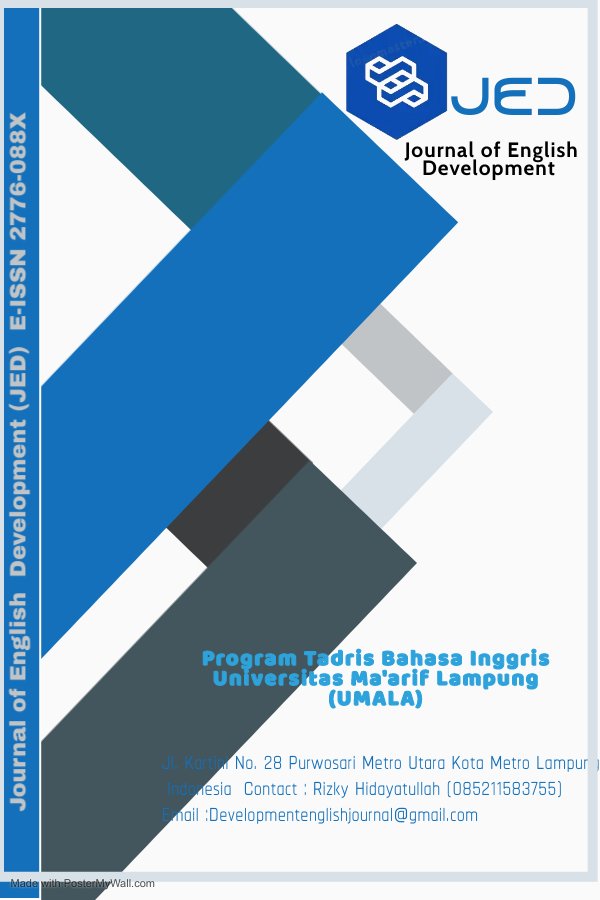Engaging Secondary School Students in the Strategy of Vocabulary Self-Collection Strategy for Learning General Vocabulary: A Classroom Action Research
English
DOI:
https://doi.org/10.25217/jed.v3i01.3839Keywords:
General Vocabulary Learning; Junior High School Students; Vocabulary Self-Collection Strategy, General Vocabulary Learning, Junior High School Students, Vocabulary Self-Collection StrategyAbstract
The objective of this study was to investigate the efficacy of the Visual Semantic method (VSS) in enhancing students' acquisition of general vocabulary, as well as to document the reactions of junior high school students towards the use of the VSS method in their vocabulary learning process. The present study employed a qualitative approach, utilizing classroom action research (CAR) as the chosen research design. The data collection methods employed by the author encompassed observation, interviews, and documentation. The present study was carried out at a junior high school located in Indonesia. The observation took place in a single classroom. The participants in this study consisted of six students enrolled in the class. The results of the study indicated that the implementation of the Vocabulary Self-Selection (VSS) strategy resulted in favorable outcomes in terms of student engagement. Specifically, students exhibited increased levels of activity and autonomy in their efforts to comprehend unfamiliar words. Moreover, students displayed a heightened curiosity towards previously unknown vocabulary encountered in the text. Additionally, the classroom environment fostered a more collaborative approach to learning. Furthermore, the students expressed a belief that engaging in group discussions proved to be highly significant as it facilitated their completion of the VSS group chart and enhanced their comprehension of the book. Regarding the challenges encountered by students in vocabulary acquisition through the use of VSS, several obstacles were identified. Firstly, students reported encountering a large number of unfamiliar words, which hindered their progress. Additionally, they expressed difficulty in comprehending the meaning of words within the context of the text. Furthermore, students acknowledged that they were encountering vocabulary that had not been previously taught in their educational curriculum, resulting in a time-consuming process of deciphering the meanings of these unfamiliar terms.
References
Adawiyah, D., & Gumartifa, A. (2022). English Language Teaching and Globatization: to Support Economic Growth. Journal of English Education and Applied Linguistics, 11(1), 228–242.
Antonacci, P. A., O’callaghan, C. M., & Berkowitz, E. (2014). Developing content area literacy: 40 strategies for middle and secondary classrooms. Sage Publications.
Creswell, J. W. (2015). Educational research: Planning, conducting, and evaluating quantitative and qualitative research. pearson.
Haggard, M. R. (1986). The vocabulary self-collection strategy: Using student interest and world knowledge to enhance vocabulary growth. Journal of Reading, 29(7), 634–642.
Harmon, J. M., Hedrick, W. B., & Wood, K. D. (2005). Research on vocabulary instruction in the content areas: Implications for struggling readers. Reading & Writing Quarterly, 21(3), 261–280.
Hayati, N. N., & Syahrul, S. (2021). The Development of Matching Game as Media to Teach Vocabulary for Elementary School Students. EduBasic Journal: Jurnal Pendidikan Dasar, 3(2), 97–106.
Indarwati, N., Firdaus, M. Z., & Maulidah, T. (2022). Application Of Reading Literacy On Speaking Skills In Speaking Text. Journal of English Development, 2(02), 75–88.
Kemmis, S., McTaggart, R., Nixon, R., Kemmis, S., McTaggart, R., & Nixon, R. (2014). Doing critical participatory action research: The ‘planner’part. The Action Research Planner: Doing Critical Participatory Action Research, 85–114.
Khodary, M. M. (2017). Using the Vocabulary Self-Collection Strategy plus to Develop University EFL Students’ Vocabulary Learning. English Language Teaching, 10(8), 135–144.
Nation, I. S. P., & Nation, I. S. P. (2001). Learning vocabulary in another language (Vol. 10). Cambridge university press Cambridge.
Ruddell, M. R., & Shearer, B. A. (2002). “ Extraordinary,”" Tremendous,"" Exhilarating"" Magnificent": Middle School at-Risk Students Become Avid Word Learners with the Vocabulary Self-Collection Strategy (VSS). Journal of Adolescent & Adult Literacy, 45(5), 352–363.
Sari, L. I., & Sutopo, D. (2018). The effectiveness of vocabulary self-collection and word mapping strategies for teaching vocabulary to maritime cadets with high and low metacognitive awareness. English Education Journal, 8(1), 35–42.
Schmitt, N. (2010). Researching vocabulary: A vocabulary research manual. Springer.
Verawati, V., Yanto, E. S., & Fitriyana, W. (2021). Students’ Perception in Instagram-Assisted Vocabulary Learning with Vocabulary Self-Collection Strategy. International Journal of Education, Information Technology, and Others, 4(3), 443–451.
Vygotskij, L. S. forme avant 2007, & John-Steiner, V. (1979). Mind in society: The development of higher psychological processes. Harvard University Press.
Widodo, H. P. (2016). The ESP Vocabulary Portfolio as a Tool for Sustained Vocabulary Learning: Student-Created Materials. In Issues in Materials Development (pp. 121–133). Brill.
Wilkins, D. A. (1972). Linguistics in language teaching (Vol. 111). Edward Arnold London.
Yanto, E. S. (2017). Implementing Vocabulary Self-Collection Strategy In The Efl College Classroom In Engaging Studentsâ€Tm Communicative Classroom. Tlemc (Teaching and Learning English in Multicultural Contexts), 1(2).
Yanto, E. S., & Nugraha, S. I. (2018). Video viewing as a mediation of learning content-based vocabulary: Assisting students in understanding disciplinary vocabulary in context. Indonesian Journal of Applied Linguistics, 8(2), 316–324

Downloads
Published
How to Cite
Issue
Section
License
Copyright (c) 2024 Alip Nurahman Sudarmaji, Elih Sutisna Yanto

This work is licensed under a Creative Commons Attribution-ShareAlike 4.0 International License.





